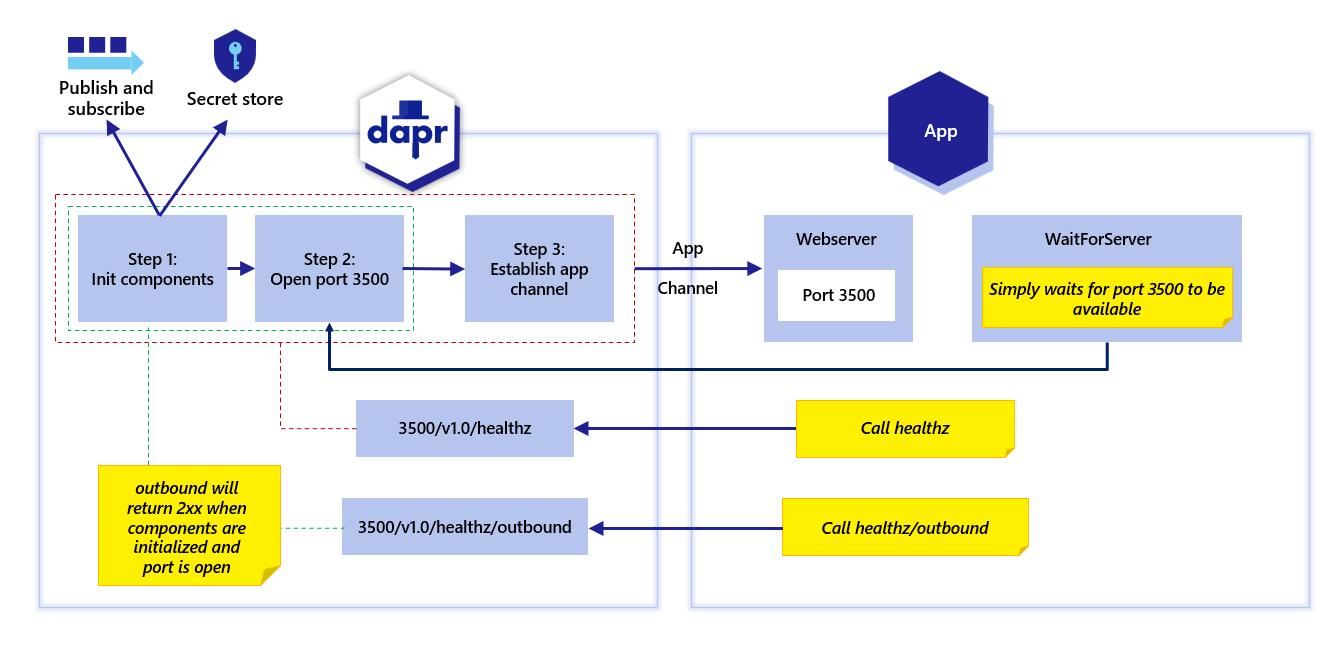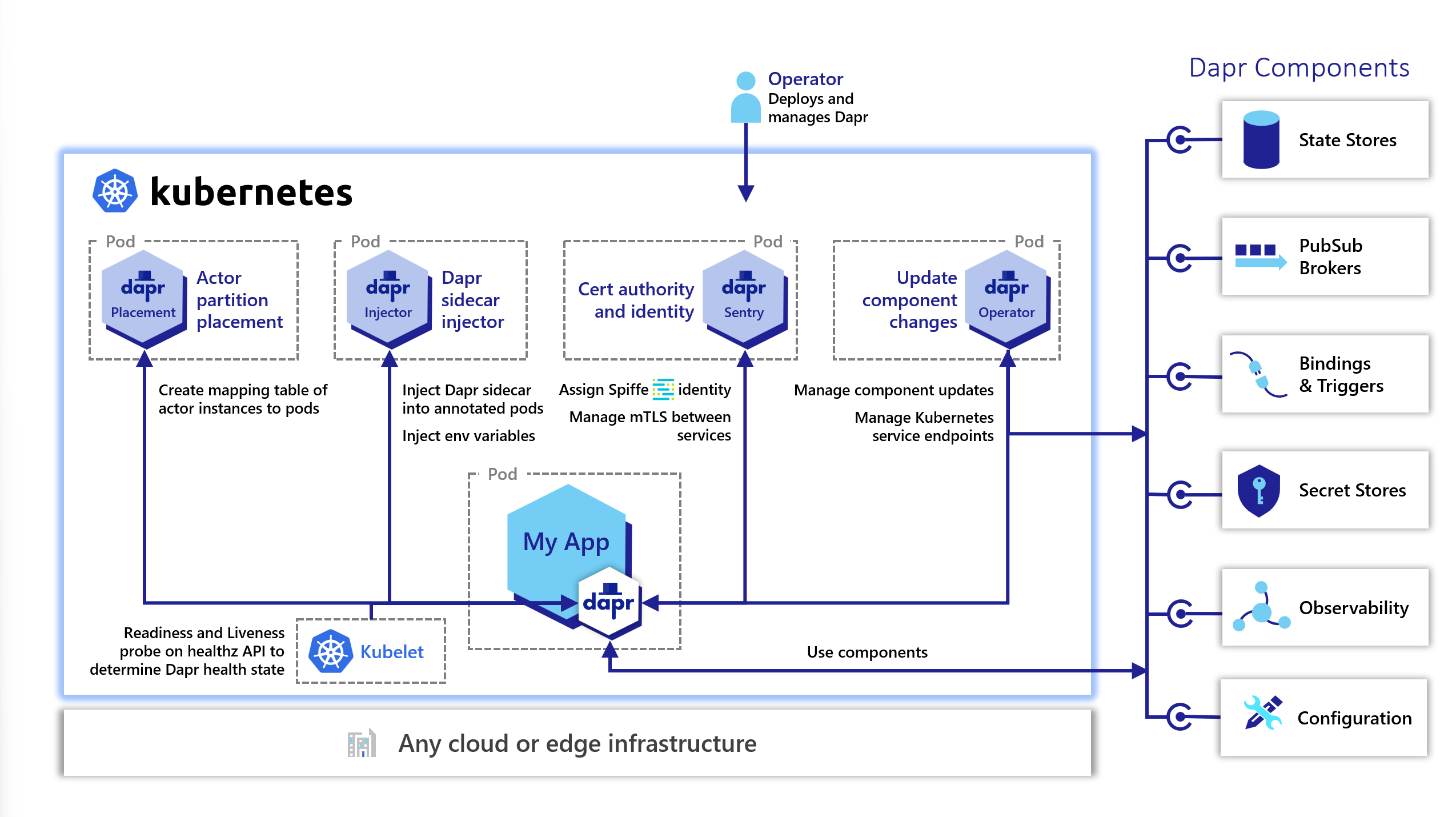The documentation you are viewing is for Dapr v1.14 which is an older version of Dapr. For up-to-date documentation, see the latest version.
Sidecar health
Dapr provides a way to determine its health using an HTTP /healthz endpoint. With this endpoint, the daprd process, or sidecar, can be:
- Probed for its overall health
- Probed for Dapr sidecar readiness during initialization
- Determined for readiness and liveness with Kubernetes
In this guide, you learn how the Dapr /healthz endpoint integrates with health probes from the application hosting platform (for example, Kubernetes) as well as the Dapr SDKs.
Note
Dapr actors also have a health API endpoint where Dapr probes the application for a response to a signal from Dapr that the actor application is healthy and running. See actor health API.The following diagram shows the steps when a Dapr sidecar starts, the healthz endpoint and when the app channel is initialized.

Outbound health endpoint
As shown by the red boundary lines in the diagram above, the v1.0/healthz/ endpoint is used to wait for when:
- All components are initialized;
- The Dapr HTTP port is available; and,
- The app channel is initialized.
This is used to check the complete initialization of the Dapr sidecar and its health.
Setting the DAPR_HEALTH_TIMEOUT environment variable lets you control the health timeout, which, for example, can be important in different environments with higher latency.
On the other hand, as shown by the green boundary lines in the diagram above, the v1.0/healthz/outbound endpoint returns successfully when:
- All the components are initialized;
- The Dapr HTTP port is available; but,
- The app channel is not yet established.
In the Dapr SDKs, the waitForSidecar/wait_until_ready method (depending on which SDK you use) is used for this specific check with the v1.0/healthz/outbound endpoint. Using this behavior, instead of waiting for the app channel to be available (see: red boundary lines) with the v1.0/healthz/ endpoint, Dapr waits for a successful response from v1.0/healthz/outbound. This approach enables your application to perform calls on the Dapr sidecar APIs before the app channel is initalized - for example, reading secrets with the secrets API.
If you are using the waitForSidecar/wait_until_ready method on the SDKs, then the correct initialization is performed. Otherwise, you can call the v1.0/healthz/outbound endpoint during initalization, and if successesful, you can call the Dapr sidecar APIs.
SDKs supporting outbound health endpoint
Currently, the v1.0/healthz/outbound endpoint is supported in the:
Health endpoint: Integration with Kubernetes
When deploying Dapr to a hosting platform like Kubernetes, the Dapr health endpoint is automatically configured for you.
Kubernetes uses readiness and liveness probes to determines the health of the container.
Liveness
The kubelet uses liveness probes to know when to restart a container. For example, liveness probes could catch a deadlock (a running application that is unable to make progress). Restarting a container in such a state can help to make the application more available despite having bugs.
How to configure a liveness probe in Kubernetes
In the pod configuration file, the liveness probe is added in the containers spec section as shown below:
livenessProbe:
httpGet:
path: /healthz
port: 8080
initialDelaySeconds: 3
periodSeconds: 3
In the above example, the periodSeconds field specifies that the kubelet should perform a liveness probe every 3 seconds. The initialDelaySeconds field tells the kubelet that it should wait 3 seconds before performing the first probe. To perform a probe, the kubelet sends an HTTP GET request to the server that is running in the container and listening on port 8080. If the handler for the server’s /healthz path returns a success code, the kubelet considers the container to be alive and healthy. If the handler returns a failure code, the kubelet kills the container and restarts it.
Any HTTP status code between 200 and 399 indicates success; any other status code indicates failure.
Readiness
The kubelet uses readiness probes to know when a container is ready to start accepting traffic. A pod is considered ready when all of its containers are ready. One use of this readiness signal is to control which pods are used as backends for Kubernetes services. When a pod is not ready, it is removed from Kubernetes service load balancers.
Note
The Dapr sidecar will be in ready state once the application is accessible on its configured port. The application cannot access the Dapr components during application start up/initialization.How to configure a readiness probe in Kubernetes
Readiness probes are configured similarly to liveness probes. The only difference is that you use the readinessProbe field instead of the livenessProbe field:
readinessProbe:
httpGet:
path: /healthz
port: 8080
initialDelaySeconds: 3
periodSeconds: 3
Sidecar Injector
When integrating with Kubernetes, the Dapr sidecar is injected with a Kubernetes probe configuration telling it to use the Dapr healthz endpoint. This is done by the “Sidecar Injector” system service. The integration with the kubelet is shown in the diagram below.

How the Dapr sidecar health endpoint is configured with Kubernetes
As mentioned above, this configuration is done automatically by the Sidecar Injector service. This section describes the specific values that are set on the liveness and readiness probes.
Dapr has its HTTP health endpoint /v1.0/healthz on port 3500. This can be used with Kubernetes for readiness and liveness probe. When the Dapr sidecar is injected, the readiness and liveness probes are configured in the pod configuration file with the following values:
livenessProbe:
httpGet:
path: v1.0/healthz
port: 3500
initialDelaySeconds: 5
periodSeconds: 10
timeoutSeconds : 5
failureThreshold : 3
readinessProbe:
httpGet:
path: v1.0/healthz
port: 3500
initialDelaySeconds: 5
periodSeconds: 10
timeoutSeconds : 5
failureThreshold: 3
Delay graceful shutdown
Dapr accepts a dapr.io/block-shutdown-duration annotation or --dapr-block-shutdown-duration CLI flag, which delays the full shutdown procedure for the specified duration, or until the app reports as unhealthy, whichever is sooner.
During this period, all subscriptions and input bindings are closed. This is useful for applications that need to use the Dapr APIs as part of their own shutdown procedure.
Applicable annotations or CLI flags include:
--dapr-graceful-shutdown-seconds/dapr.io/graceful-shutdown-seconds--dapr-block-shutdown-duration/dapr.io/block-shutdown-duration--dapr-graceful-shutdown-seconds/dapr.io/graceful-shutdown-seconds--dapr-block-shutdown-duration/dapr.io/block-shutdown-duration
Learn more about these and how to use them in the Annotations and arguments guide.
Related links
Feedback
Was this page helpful?
Glad to hear it! Please tell us how we can improve.
Sorry to hear that. Please tell us how we can improve.